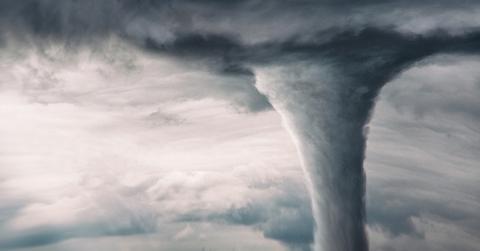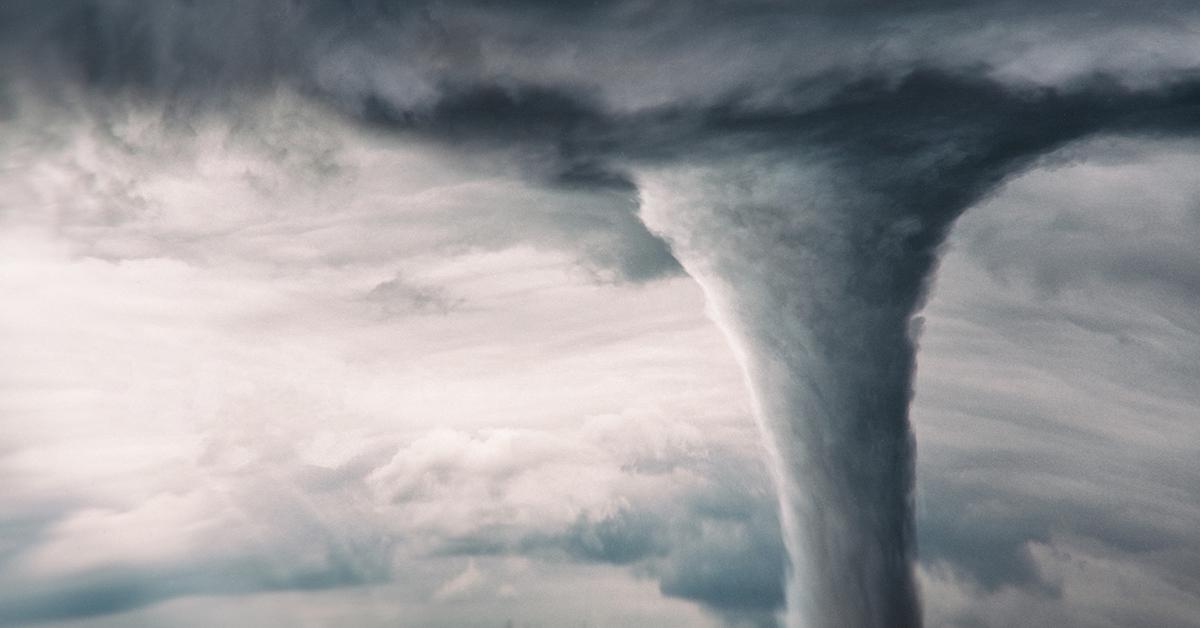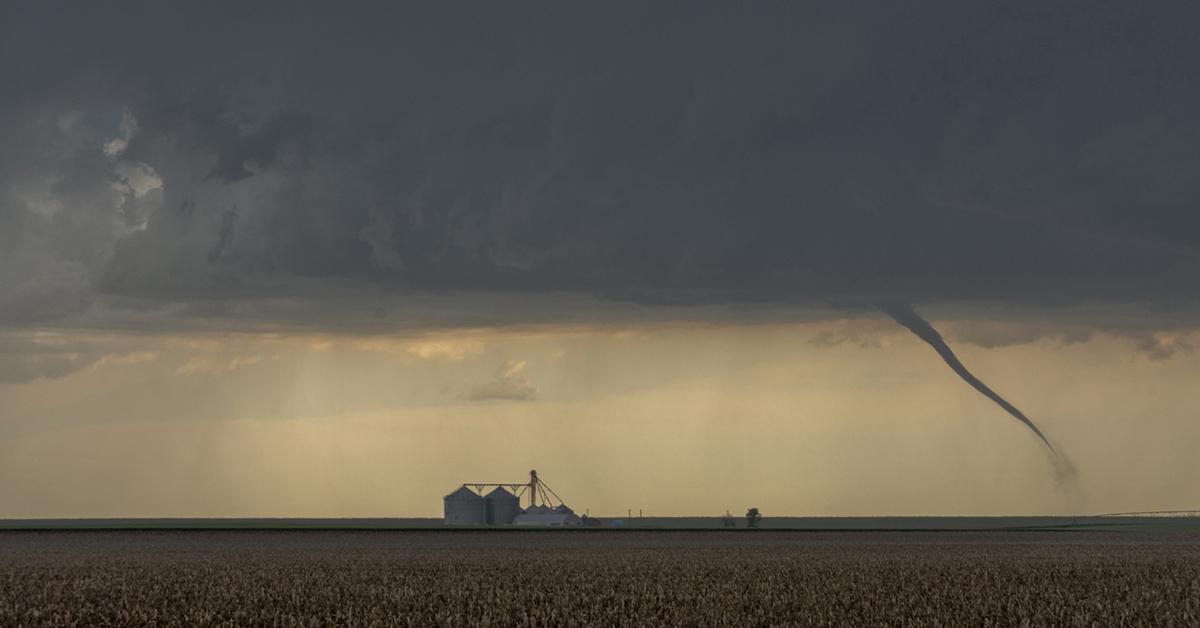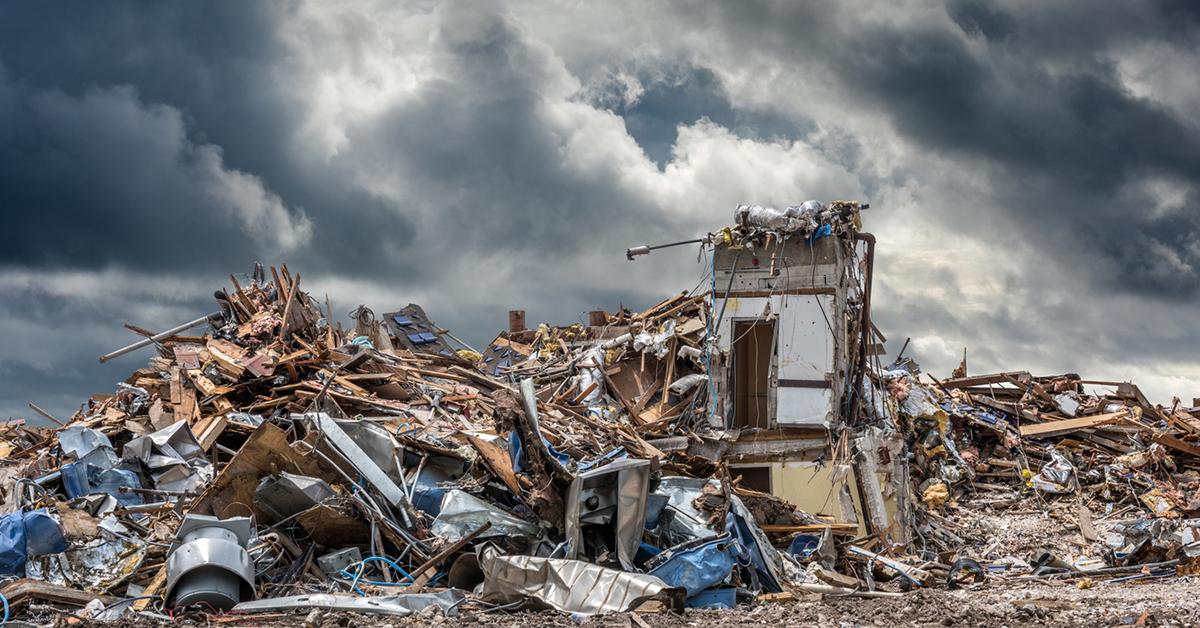How Do Tornadoes Form?
Updated Sept. 10 2020, 11:02 a.m. ET

Extreme weather events become more frequent as a result of climate change and the steady increase of the average global temperature. These can include hurricanes, drought, heat waves, and in general, more frequent, more intense storms, according to the Environmental Defense Fund (EDF). Though climate change doesn’t necessarily equate to an increase in tornadoes, National Geographic writes that climate change could result in more storms. Only about 20 percent of storms transform into tornadoes, but even still, climate change has the potential to impact the number of tornadoes we endure per year.
A tornado is a rapidly rotating column of air that touches both the Earth’s surface on one end and, on the other, a cumulonimbus cloud. In some very rare cases, a tornado can contact the Earth’s surface on one end and then a cumulus cloud on the other, but typically tornadoes are characterized by contact with a cumulonimbus.
Tornadoes — also known as twisters — are violent and can leave behind massive destruction in their wake. In fact, it’s their rotation that makes them most dangerous. The column of air rotates with speeds of up to 300 miles per hour, allowing tornadoes to be strong enough to pick up just about anything — from a person or a cow to a car or a house.
But even though we know a lot about the destruction a tornado can cause, still not much is understood about how they are formed. After all, there are lots of storms, but as mentioned above, only about 20 percent of them amount to tornadoes. So, how does a tornado form, what is it made of, and are they predictable?
Keep reading for more info on how tornadoes form.
How do tornadoes form?

Believe it or not, it’s a complicated question. Tornado formation is not as universally understood as the formation of hurricanes, hail, or other weather events. Tornadoes form as a result of strong storms, but since not all storms become tornadoes, their formations can be tricky to predict.
According to the National Severe Storms Laboratory (NSSL), “The truth is that we don’t fully understand. The most destructive tornadoes occur from supercells, which are rotating thunderstorms with a well-defined radar circulation called a mesocyclone. (Supercells can also produce damaging hail, severe non-tornadic winds, frequent lightning, and flash floods).”
The NSSL adds, “Tornado formation is believed to be dictated mainly by things which happen on the storm scale, in and around the mesocyclone.”
When it comes to tornado formation, we do know that two things are necessary: warm, moist air from the Gulf of Mexico and cool, dry air from Canada. According to Weather Wiz Kids, “When these two air masses meet, they create instability in the atmosphere. A change in wind direction and an increase in wind speed with increasing height creates an invisible, horizontal spinning effect in the lower atmosphere. Rising air within the updraft tilts the rotating air from horizontal to vertical.” That area of rotation can measure anywhere from two to six miles wide.
What is a tornado made of?
Tornadoes are the result of intense storms and are categorized by warm, moist air, cool, dry air, and wind. Because wind is invisible, tornadoes can sometimes be invisible. That is, unless the tornado forms a condensation funnel — a funnel made of water droplets, dust, and debris that, according to the NSSL, “extends downward from the base of the thunderstorm.”
To be considered a tornado, the funnel must be in contact with both the ground and the air. If it doesn’t make contact with the ground, it’s considered a funnel cloud.
Are tornadoes predictable?
Despite recent advances in science, not much is understood about tornadoes, rendering them as one of the most unpredictable weather events. However, there are a few key factors understood about tornadoes that make them somewhat predictable.
For starters, there is a stark difference between a tornado watch and a tornado warning. A Tornado Watch, the NSSL explains, is issued by the NOAA Storm Prediction Center and signifies that current weather conditions may be favorable for the formation of tornadoes. However, a tornado warning is more certain; issued by the local NOAA National Weather Service Forecast Office by meteorologists keeping a watchful eye on the weather, a tornado warning indicates that a tornado has been reported by either spotters or radar. A tornado warning indicates “a serious threat to life and property to those in the path of the tornado.” If a tornado warning is issued in your area, you should immediately seek safe shelter.
Beyond warnings and watches, there are a few things about tornadoes that scientists keep in mind when paying close attention to them. Meteorologists might not be able to always correctly predict what a tornado will do or when it will form, but we know that generally, tornadoes only last for ten minutes; however, bigger tornadoes can last up to 30 minutes.
Understanding the strength of a tornado can also help its predictability. Bigger, more powerful tornadoes can have wind speeds of more than 300 miles per hour, according to National Geographic, which significantly exacerbates the threat. But the most common wind speeds for tornadoes are less than 110 miles per hour and only spin for a few miles before burning out.
Can tornadoes happen anywhere?

Tornadoes have been reported on every continent in the world except for Antarctica, according to National Geographic. However, “Tornado Alley” refers to the most commonly affected area by tornadoes in the United States and ranges from Kansas, Nebraska, North and South Dakota to Texas. About 1,200 tornadoes strike the U.S. each year – the bulk of which take place in Tornado Alley.
Can tornadoes form over water?
Technically, a tornado can form over water, but, most commonly, it’s hurricanes that do so. According to the National Oceanic and Atmospheric Association (NOAA), if a tornado forms over water or moves from the land to the water, it is called a tornadic waterspout.
“They have the same characteristics as a land tornado,” the NOAA says. “They are associated with severe thunderstorms and are often accompanied by high winds and seas, large hail, and frequent, dangerous lightning.”
However, whether a tornado has formed on land or on water, you won’t notice a difference in the warning. “If a waterspout moves onshore, the National Weather Service issues a tornado warning, as some of them can cause significant damage and injuries to people.” However, fair weather waterspouts – waterspouts formed over water that are not associated with thunderstorms — tend to wreak little havoc when they make landfall and don’t get very far.
Can tornadoes pick up cars?

Perhaps the most frightening element of tornadoes is their strength, as strong winds make a tornado capable of picking up and transferring debris miles and miles away from its origin point. The NOAA reports that tornadoes kill an average of 60 people per year in the U.S., and most of those fatalities are the result of the debris tornadoes pick up and deposit elsewhere.
One item that tornadoes are known to pick up are cars. Tornadoes have also picked up people, animals, and houses that aren’t well-framed or tornado-proofed with thick concrete anchoring it to the ground.
The heaviest item on record that a tornado has ever picked up is machinery that weighed more than 30,000 pounds. According to the Farmer’s Almanac, the machinery was picked up by a tornado in Pampa, Texas in 1995.